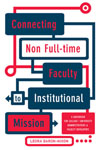Home » Resources » Scholarship on Teaching » Connecting Non Full-time Faculty to Institutional Mission: A Guidebook for College/University Administrators & Faculty Developers
Scholarship
March 29, 2017
Connecting Non Full-time Faculty to Institutional Mission: A Guidebook for College/University Administrators & Faculty Developers

- Author
- Baron-Nixon, Leora
- Publisher
- Stylus, Sterling, VA
Adjuncts have become the lifeline of a vast majority of colleges and universities. They teach many of the foundation and core courses taken by first and second year students, they teach professional courses in which their own life experiences are invaluable, and they step in on short notice to fill in for regular faculty engaged in research or away on sabbaticals.
A survey of over 4,000 institutions conducted by the US Department of Education reveals that adjuncts are being hired at a much higher rate than full-time faculty. This is due partly to increased enrollment, partly to reduced budgets, partly as a deliberate administrative strategy, and partly to convenience.
The importance of adjuncts to the college or university cannot be overstated. This book provides academic administrators and faculty developers with proactive, practical and results-producing approaches that can help transform fragmented faculties into inclusive and cohesive teaching and scholarly communities.
Structured in an easy-to-follow, practical format, this book provides an invaluable resource of thoughtful and pragmatic approaches to ensure the both quality and satisfaction on the part of the institution and the adjuncts. Topics are presented in a thematic sequence that allows decision-makers to focus on their priority areas; guidance is provided for systematic planning and implementation.
The contents focus on connecting adjunct faculty to core institutional functions and structures: Connection #1 - To The Institution; Connection #2 - To The Department; Connection #3 - To The Profession & The Discipline; Connection #4 - To Teaching; Connection #5 - To Students; Connection #6 - To Scholarship. (From the Publisher)
A survey of over 4,000 institutions conducted by the US Department of Education reveals that adjuncts are being hired at a much higher rate than full-time faculty. This is due partly to increased enrollment, partly to reduced budgets, partly as a deliberate administrative strategy, and partly to convenience.
The importance of adjuncts to the college or university cannot be overstated. This book provides academic administrators and faculty developers with proactive, practical and results-producing approaches that can help transform fragmented faculties into inclusive and cohesive teaching and scholarly communities.
Structured in an easy-to-follow, practical format, this book provides an invaluable resource of thoughtful and pragmatic approaches to ensure the both quality and satisfaction on the part of the institution and the adjuncts. Topics are presented in a thematic sequence that allows decision-makers to focus on their priority areas; guidance is provided for systematic planning and implementation.
The contents focus on connecting adjunct faculty to core institutional functions and structures: Connection #1 - To The Institution; Connection #2 - To The Department; Connection #3 - To The Profession & The Discipline; Connection #4 - To Teaching; Connection #5 - To Students; Connection #6 - To Scholarship. (From the Publisher)